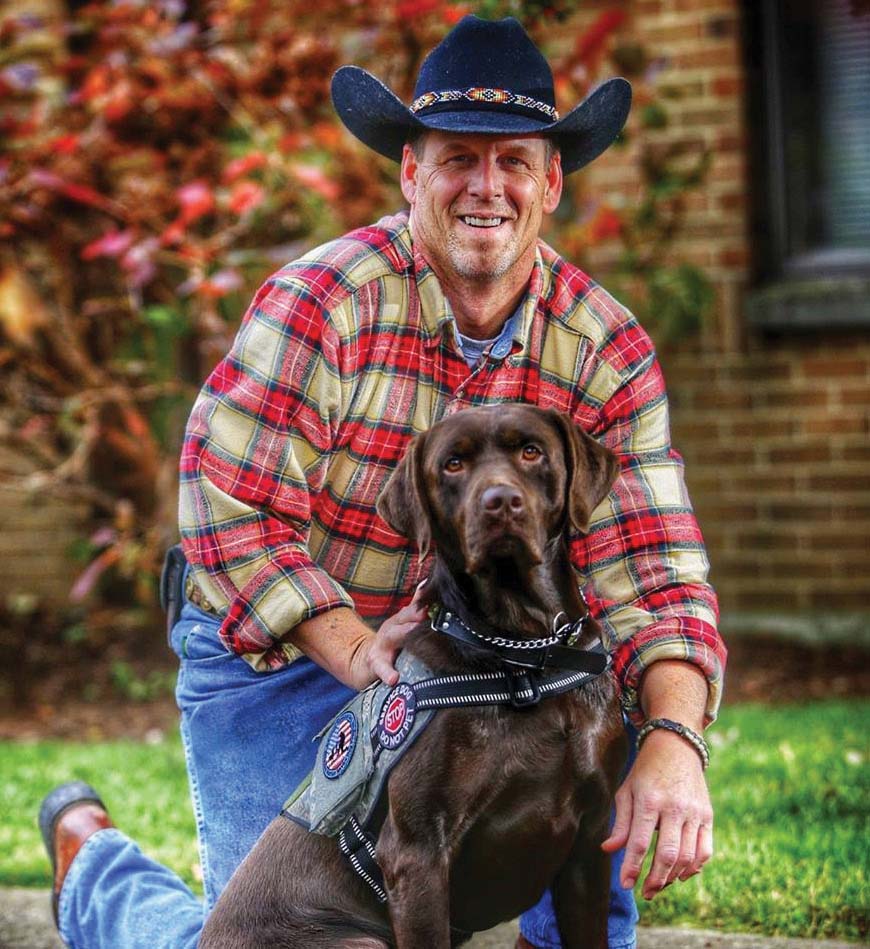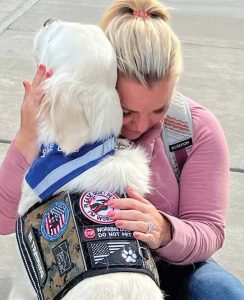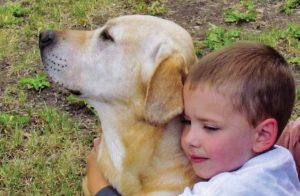
22 Nov ROUND UP SPOTLIGHT: K9 CARE MONTANA
Some people are born to do amazing things, but not before a baptism in fire. David Riggs, founder of K9 Care Montana, is one of them. At just 17, Riggs was profoundly injured, paralyzed, and left in a wheelchair with surgeries and little else to define his future. But his road to recovery led to a lifetime of service to others, led to the gift of hope.
The only entity of its kind in the state, K9 Care has provided service dogs at no cost to wounded veterans, first responders, and families challenged by autism throughout Montana since 2009. Guided by Riggs’ vision and made possible through committed help from friends, furry and otherwise, K9 Care service dogs offer previously unimagined independence, mobility, support, and healing. Accolades acknowledging Riggs’ impact and reach on families abound, from recently receiving the Governor’s Award with his K9 Care battle buddy at his side to a feature in the New York Times bestseller Travels with Casey to testimonial after testimonial from recipients whose lives have been forever changed.


K9 CARE PROVIDES NO-COST SERVICE DOGS TO FIRST RESPONDERS, WOUNDED VETERANS, AND CHILDREN CHALLENGED BY AUTISM. PROGRAM GRADUATES MACY AND ROCKY HAVE GIVEN THEIR RESPECTIVE RECIPIENTS FREEDOM, SECURITY, SUPPORT, AND HOPE, NO SMALL FEAT FOR ANY COMPANION, FURRY OR OTHERWISE. | COURTESY OF K9 CARE MONTANA
Here, Riggs describes his trajectory from traumatic injury to training service dogs, his vision for K9 Care, and his intention to do all things with love.
BIG SKY JOURNAL: Why did you first launch K9 Care? Since founding it in 2009, how many dogs have you trained and matched, and how has the organization’s mission evolved?
DAVID RIGGS: I first knew I wanted to assist with training dogs in 2001 when I was at my grandfather’s hospital bedside watching the World Trade Center towers fall in New York City. He was a West Point graduate and had served in World War II. He passed away a week later.
On April 10, 2007, a Philipsburg, Montana native, well-loved community leader, and son of a neighboring rancher, Pfc. Kyle Bohrnsen, was killed when his Humvee hit an improvised explosive device in Baghdad, Iraq. When I witnessed the entire community of Philipsburg mourn the loss of their own, I knew with absolute certainty that I had to help somehow. Every project we complete, every activity in which we participate, is in honor and memory of Bohrnsen and so many other fallen soldiers so that they are ‘Always remembered and never forgotten.’
In 2009, I developed K9 Care while living at a large ranch on Rock Creek, southwest of Philipsburg. Since our first endeavors, K9 Care’s programming and service offerings have grown and expanded in all directions. Our focus on providing quality service and building relationships along the way has been key: We are always striving to find ways to improve.
We’ve assisted over 100 veterans, primarily through service dog projects. We provide mobility and psychiatric service dogs at no cost to wounded veterans, first responders, and families challenged by autism throughout Montana. In addition to our service dog program, K9 Care provides free customized outdoor activities to our recipients, including fly fishing on the Yellowstone and Missouri rivers, pheasant hunting every Veterans Day, ice fishing, elk hunting, and rafting on the Yellowstone River.
And it’s all, of course, thanks to our amazing donors, supporting foundations, volunteers, professional breeders, transporters, veterinarians, and trainers.
BSJ: How does the dog’s temperament and training differ between a service dog meant for an autistic child and one for a veteran struggling with PTSD?
RIGGS: K9 Care’s primary objective is to establish and encourage independence for people with disabilities. That starts with recipients embracing and understanding their disability, acknowledging that they can’t do it all themselves, and being willing to accept help.
Choosing a compatible breed that can help mitigate a specific disability is, of course, important, as is temperament testing the animal to ensure it’s suited to the working lifestyle and demands of service dog training. While training the dog to perform at least one task to mitigate the specific disability distinguishes it as a service dog, impeccable obedience training is required of all service dogs.
A service dog that assists a child with autism and one that assists a disabled veteran challenged by PTSD are both considered psychiatric service dogs. Their difference lies in the tasks they are trained to provide. For instance, we might train a psychiatric service dog mitigating autism to provide compression or encourage it to engage in general public interaction — like petting — to aid in socializing its handler. Whereas a psychiatric service dog mitigating PTSD for a veteran might be trained to ‘block and post,’ essentially preventing people from invading the veteran’s personal space. This service dog might include a ‘do not pet’ patch on its vest, informing the public not to touch or distract the dog while it’s working.
BSJ: After investing so much of yourself in training and developing a trusting bond with each animal, do you ever find it hard to say goodbye? Or vice versa?
RIGGS: As with the recipients, all of the service dogs provided by K9 Care are family, and we love each and every one of them. Based on my experience, they love us back equally. We do regular follow-ups throughout the dog’s lifetime, so there is never a true ‘goodbye,’ it’s more like a simple ‘see you later;’ though, occasionally, and as one might expect, the emotions can run high. In short, yes, it’s hard, but we stay focused on our objective and are comforted in knowing that each of the animals we get to know and love is going on to improve the life of a deserving person in need.
BSJ: What’s your favorite before-and-after story in all of your years of making these matches?
RIGGS: I’ve been really blessed by being able to help so many with the gift of a service dog. Of all the service dog projects I’ve facilitated over the past 15 years, however, the one that sticks out to me the most is a young nonverbal child challenged by autism who is now verbal and a teenager in mainstream schooling. The family credits our program and his dog for all of it. It’s a truly heartwarming example of why we do what we do. K9 Care continues to be the only established Montana nonprofit that provides service dogs at no cost to children and families facing autism in the state.
And this is all in addition to our work with a range of disabled-veteran projects, which have consistently credited our program for not only being life-changing but, for many, lifesaving. To date, we’ve had zero suicides among the veterans we’ve matched with a dog. The impact and influence of these working animals is incomprehensibly profound.
BSJ: How has training service dogs and providing this gift to so many over the years impacted the course of your life?
RIGGS: At this stage of my life, I cannot imagine doing anything else. As I age, I hope to always be involved in assisting people in need to the best of my capacity and to incorporate service dogs in that work.
I was severely injured by a gunshot wound at 17 years old and paralyzed in a wheelchair for over a year. I know what it’s like to recover from a trauma injury. And I know that it was a dog that gave me my life back. Today, I use my own life experiences to help others. I have had the pleasure of being owned by six mobility-based service dogs over the last 40 years. I would not be where I am today if not for the gift of those dogs, and I want, more than anything, for our K9 Care recipients to know that same blessing.
BSJ: What is the best advice you can give someone trying to train their own dog, and what do you think we most misunderstand in working with, supporting, and loving our canine companions?
RIGGS: In Montana, we have a state law that aligns with the Americans with Disabilities Act (ADA) — legislation that governs service dogs and protects the rights of people with disabilities in the U.S. — that allows people to personally train their own service dogs. We encourage self-trainers to embrace their disability and educate themselves, to the best of their ability, regarding their rights and responsibilities as a service dog handler and owner, according to the ADA and our state law. That knowledge, as the adage acknowledges, is power and is important when navigating public access.
Regarding training specifics, we use the old school training philosophy of positive reinforcement, lots of repetition, and strong relationships built on trust between dog and handler. I’ve been professionally training dogs since 1989, and this approach has yet to fail me.
K9 Care Montana relies heavily on donor and volunteer support to continue its mission. For more information, or to volunteer, donate, apply for a service dog, or catch the organization’s new podcast, visit k9caremontana.org.




No Comments